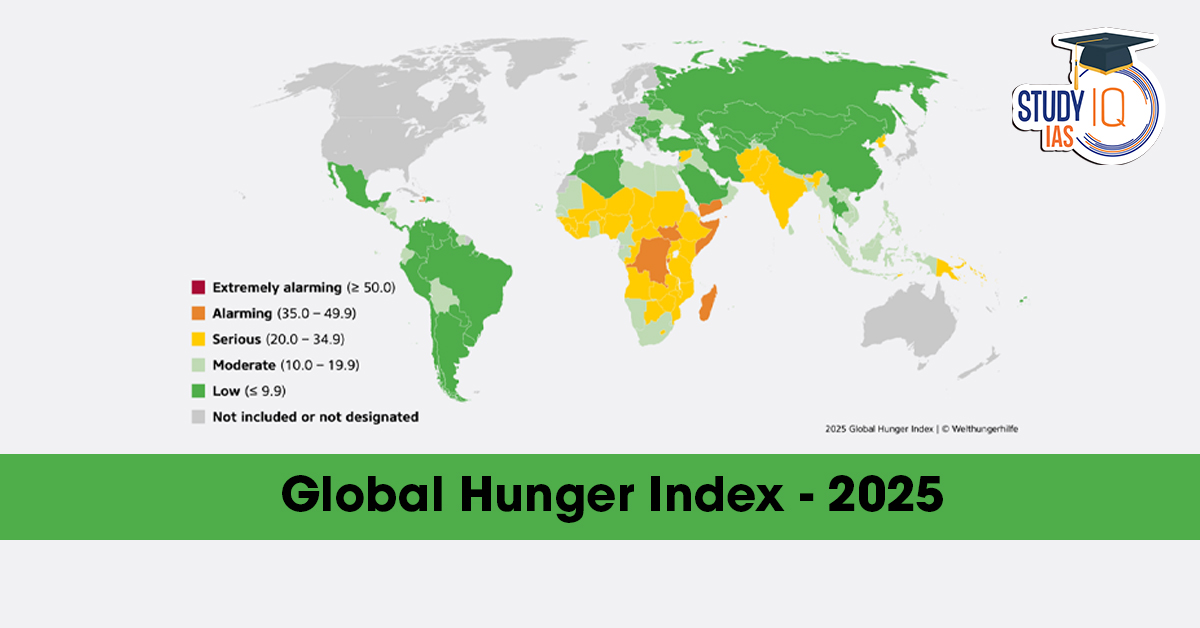Table of Contents
The Global Hunger Index (GHI) 2025 titled “20 Years of Tracking Progress: Time to Recommit to Zero Hunger” has been released, highlighting the world’s slow progress toward ending hunger. Despite early advancements, global hunger levels have barely improved since 2016, threatening the achievement of the United Nations Sustainable Development Goal (SDG) 2 — Zero Hunger by 2030.
The report underscores that 56 countries are projected not to achieve “low hunger” status by 2030, reflecting the urgent need for renewed international commitment, sustainable food systems, and political action.
Who Publishes the Global Hunger Index?
The Global Hunger Index (GHI) is published annually by:
-
🇮🇪 Concern Worldwide (Irish humanitarian organization)
-
🇩🇪 Welthungerhilfe (German aid agency)
-
🕊️ Institute for International Law of Peace and Armed Conflict (IFHV)
These institutions collectively monitor global hunger and malnutrition trends and provide a comprehensive analysis of how nations are performing on food security and nutrition.
Global Hunger Index 2025 – Key Highlights
| Parameter | Details (2025 Report) |
|---|---|
| Global Theme | “20 Years of Tracking Progress: Time to Recommit to Zero Hunger” |
| Global GHI Score | 18.3 (Moderate Hunger) |
| No. of Countries Assessed | 123 |
| Countries with Serious or Alarming Hunger | 42 |
| India’s Rank | 102nd |
| India’s Score | 25.8 (Serious Category) |
| Report Released by | Concern Worldwide, Welthungerhilfe, and IFHV |
| Publication Date | October 15, 2025 |
What is the Global Hunger Index (GHI)?
The Global Hunger Index is a composite tool designed to measure and track hunger and undernutrition at global, regional, and national levels.
It assigns each country a score ranging from 0 (best) to 100 (worst) — where lower scores indicate lesser hunger.
Indicators Used in GHI Calculation:
-
Undernourishment – Share of the population with insufficient caloric intake.
-
Child Stunting – Percentage of children under five who have low height for their age, indicating chronic undernutrition.
-
Child Wasting – Percentage of children under five who have low weight for their height, indicating acute undernutrition.
-
Child Mortality – Mortality rate of children under five, reflecting poor nutrition and healthcare access.
Global Findings: Hunger Levels in 2025
According to the 2025 report, global hunger levels remain “moderate” but have shown minimal improvement since 2016.
The global GHI score of 18.3 demonstrates stagnation, with regional disparities widening due to conflict, climate shocks, and economic instability.
Countries with Alarming Hunger Levels
Seven nations fall into the “alarming” category:
-
Burundi
-
Democratic Republic of Congo (DRC)
-
Haiti
-
Madagascar
-
Somalia
-
South Sudan
-
Yemen
Countries with Serious Hunger
35 countries show serious hunger, with worsening food insecurity since 2016.
Alarmingly, hunger has increased in 27 nations, reversing earlier progress made in the early 2000s.
Regional Analysis of Global Hunger 2025
1. Africa South of the Sahara
-
Remains the most hunger-affected region globally.
-
Six countries face “extremely alarming” hunger levels.
-
Climate change, ongoing conflicts, and poor governance are the key causes.
2. South Asia
-
Continues to face serious hunger challenges.
-
Child stunting and undernourishment remain among the highest globally.
-
Economic inequality and climate vulnerability exacerbate food insecurity.
3. West Asia & North Africa
-
Hunger remains moderate but has worsened due to wars (Yemen, Syria, Gaza) and economic instability.
4. Latin America & the Caribbean
-
Hunger levels have risen since 2015 due to inflation, migration crises, and climate shocks.
5. East & Southeast Asia
-
Low hunger levels overall but progress has slowed in recent years due to urban poverty and environmental challenges.
6. Europe & Central Asia
-
Lowest hunger levels worldwide thanks to strong economies and social protection systems.
India’s Position in Global Hunger Index 2025
India is ranked 102nd out of 123 countries, with a GHI score of 25.8, placing it in the “serious hunger” category.
Although India has made strides in food distribution and social welfare schemes, it still struggles with child malnutrition, inequality, and dietary deficiencies.
India’s Indicator-Wise Performance
| Indicator | India’s Status (2025) |
|---|---|
| Undernourishment | Around 15% of population faces insufficient calorie intake. |
| Child Stunting | ~35% of children under 5 are stunted. |
| Child Wasting | ~18% of children under 5 are wasted – among the world’s highest. |
| Child Mortality | Declining trend due to improved healthcare access. |
Government Schemes Addressing Hunger in India
-
POSHAN Abhiyaan – To reduce malnutrition among children and women.
-
PM Garib Kalyan Anna Yojana (PMGKAY) – Free food grains for poor families.
-
Mid-Day Meal / PM POSHAN – Nutritional meals for school children.
-
Integrated Child Development Services (ICDS) – Focused on early childhood nutrition and health.
Despite these, implementation gaps and unequal access continue to challenge India’s hunger reduction efforts.
Causes Behind the Global Hunger Crisis
The 2025 GHI identifies five key reasons for persistent hunger worldwide:
| Cause | Description |
|---|---|
| Conflict | The primary driver of hunger; wars displace populations and destroy food systems. |
| Climate Change | Floods, droughts, and heatwaves disrupt agriculture and reduce productivity. |
| Economic Fragility | Inflation and currency depreciation make food unaffordable for millions. |
| Reduced Humanitarian Aid | Declining international aid budgets hinder crisis response. |
| Income Inequality | Wealth gaps prevent equitable access to nutritious food. |
These interrelated factors deepen food insecurity, particularly in fragile and conflict-affected states.
Countries Showing Notable Progress
Despite global challenges, some countries have shown remarkable improvement in hunger reduction:
| Country | Achievement |
|---|---|
| Tajikistan | Shifted from “alarming” to near-low hunger category. |
| Mozambique & Rwanda | Improved through national nutrition programs. |
| Nepal & Ethiopia | Achieved reductions in stunting through rural development and health reforms. |
| Bangladesh & Sierra Leone | Steady progress in food security via targeted social schemes. |
These examples show that sustained political will and investment can bring tangible improvements.
20 Years of Global Hunger Tracking (2005–2025)
Over the past two decades, the GHI has tracked progress and exposed vulnerabilities in global food systems.
Key Lessons:
-
Global hunger declined sharply between 2000 and 2015, but progress stalled post-2016.
-
Wars, climate change, and inequality have become the dominant drivers of food insecurity.
-
Women and children remain the most affected groups.
-
The COVID-19 pandemic and subsequent economic shocks deepened existing disparities.
Way Forward: Recommitting to Zero Hunger
The 2025 Global Hunger Index emphasizes that ending hunger is achievable — but only through collective, strategic action.
Recommendations:
-
Transform food systems to become sustainable and climate-resilient.
-
Invest in local agriculture and smallholder farmers.
-
Strengthen global cooperation in conflict and post-conflict zones.
-
Promote equitable access to nutrition and healthcare.
-
Enhance early-warning systems to predict and mitigate food crises.
Without urgent action, millions will remain trapped in hunger, undermining global stability and human development.
Conclusion
The Global Hunger Index 2025 is both a warning and a call to action. With the world’s hunger score stagnating at 18.3 and India ranking 102nd, the report makes it clear that the SDG target of Zero Hunger by 2030 is slipping out of reach.
To change this trajectory, nations must recommit to global solidarity, equitable food policies, and climate-resilient agricultural systems. Only through united global efforts can hunger and malnutrition truly be eradicated.


 World Summit on Disaster Management (WSD...
World Summit on Disaster Management (WSD...
 Domestic Systemically Important Banks (D...
Domestic Systemically Important Banks (D...
 The Missing Link in India’s Critical M...
The Missing Link in India’s Critical M...

























